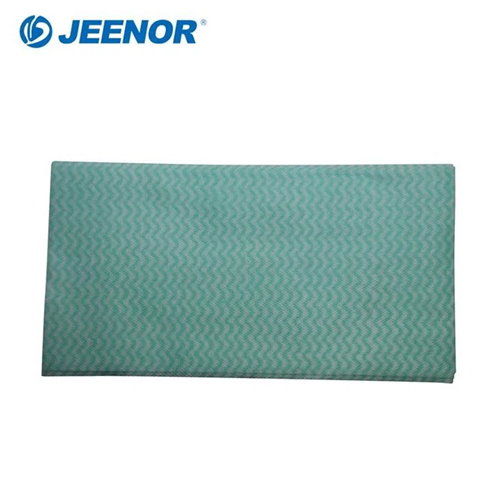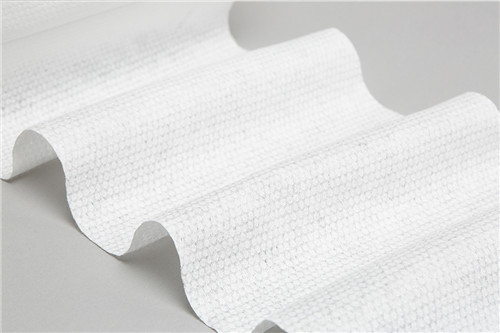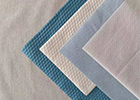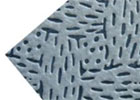Eco-friendly and Sustainable Production Methods for Spunlace Nonwoven Fabric
|
Chemical Usage and Waste Management Production Process Optimization Eco-friendly and Sustainable Production Methods for Spunlace Nonwoven Fabric |
Introduction
When it comes to producing nonwoven fabrics, it's important to consider the environmental impact of the production methods. Eco-friendly and sustainable production methods not only help protect the environment but also benefit businesses in the long run. One such method is the production of spunlace nonwoven fabric.
Importance of eco-friendly and sustainable production methods
Reducing environmental impact: Choosing eco-friendly and sustainable production methods for nonwoven fabric helps minimize the negative impact on the environment. Traditional methods often involve the use of harmful chemicals and excessive energy consumption, leading to pollution and depletion of resources. By utilizing more sustainable practices, businesses can contribute to a greener and cleaner future.
Meeting consumer demand: Today's consumers are increasingly conscious of the environmental impact of the products they use. By adopting eco-friendly production methods, businesses can attract environmentally conscious consumers who value sustainability. This can lead to increased customer loyalty and positive brand reputation.
Benefits of using spunlace nonwoven fabric
High quality and versatility: Spunlace nonwoven fabric is known for its superior quality and versatility. It is made by intertwining fibers through high-pressure water jets, creating a strong and durable material. This fabric can be used in various applications such as hygiene products, medical supplies, and industrial wipes.
Eco-friendly production process: The production of spunlace nonwoven fabric is considered more eco-friendly compared to other nonwoven fabric manufacturing methods. It requires less energy and chemical usage, resulting in a lower carbon footprint. Additionally, spunlace nonwoven fabric is biodegradable, making it a sustainable choice for businesses looking to reduce their environmental impact.
Enhanced comfort and performance: Spunlace nonwoven fabric offers excellent softness, breathability, and absorbency, making it highly comfortable for users. Its unique structure provides superior strength and tear resistance, allowing it to withstand rigorous use without compromising performance.
In conclusion, adopting eco-friendly and sustainable production methods for nonwoven fabrics, specifically spunlace nonwoven fabric, is a smart choice for both businesses and the environment. By reducing environmental impact and meeting consumer demands for sustainability, businesses can not only protect the planet but also gain a competitive edge in the market.

Water and Energy Conservation
Spunlace nonwoven fabric production is a complex process that requires significant amounts of water and energy. As sustainability becomes a priority for businesses, adopting eco-friendly production methods can help reduce the environmental impact of this industry.
Efficient water usage in spunlace nonwoven fabric production
One crucial aspect of eco-friendly production is the efficient use of water resources. To minimize water consumption, manufacturers can implement several strategies:
1.Water recycling: Reusing water in the production process can significantly reduce water consumption. By treating and purifying wastewater, manufacturers can recycle it for other purposes within the facility.
2.Water-efficient equipment: Upgrading machinery and equipment with water-saving features can help minimize water usage. Investing in technology that optimizes water flow, reduces leakage, and implements automated controls can lead to substantial water conservation.
3.Process optimization: Analyzing and optimizing production processes can help identify areas where water usage can be minimized. By implementing more efficient practices, such as adjusting water pressure, temperature, or chemical usage, manufacturers can conserve water without compromising product quality.
Renewable energy sources for manufacturing
In addition to water conservation, utilizing renewable energy sources in the production of spunlace nonwoven fabric can further enhance sustainability. Here are some options:
1.Solar power: Installing solar panels on the factory roof can generate clean, renewable electricity. This reduces reliance on fossil fuel-powered grids and lowers carbon emissions.
2.Wind power: Wind turbines can be utilized to harness wind energy, providing a sustainable source of power for manufacturing processes.
3.Biomass energy: Biomass, such as agricultural waste or wood pellets, can be converted into energy to run the production facility. This helps reduce reliance on non-renewable sources like coal or natural gas.
By implementing these eco-friendly production methods, the spunlace nonwoven fabric industry can minimize its environmental footprint and contribute to a more sustainable future.
Note to the AI writer: Please ensure a smooth transition between the sentences and paragraphs to maintain coherence.

Raw Material Selection
When it comes to producing spunlace nonwoven fabric, adopting eco-friendly and sustainable production methods is crucial. These methods not only help protect the environment but also contribute to the overall image and reputation of the company. Here are some key points to consider:
Using recycled or sustainably sourced fibers
To promote sustainability, manufacturers can opt for using recycled fibers for producing spunlace nonwoven fabric. This means utilizing fibers from post-consumer waste or industrial by-products. Additionally, sourcing fibers from sustainable and responsibly managed forests can greatly reduce the environmental impact.
By incorporating these practices, companies can minimize deforestation, conserve natural resources, and reduce carbon emissions. It also sends a positive message to consumers who prioritize eco-friendly products.
Reducing waste and pollution in raw material processing
Efforts to minimize waste and pollution in raw material processing are key to eco-friendly production. Companies can achieve this by implementing sustainable practices throughout the production process:
1.Energy-efficient machinery: Using modern and energy-efficient machinery reduces energy consumption and lowers carbon emissions. This helps reduce the environmental footprint of the production process.
2.Water recycling: Implementing water recycling systems can significantly reduce water usage and prevent pollution of water sources. It also minimizes the need for drawing freshwater resources, a finite and valuable asset.
3.Waste management: Implementing proper waste management systems, such as segregating and recycling waste materials, can help minimize landfill contributions and environmental pollution.
4.Chemical alternatives: Exploring and implementing eco-friendly alternatives to chemicals used in the production process can greatly reduce pollution and environmental impact.
By embracing these measures, manufacturers of spunlace nonwoven fabric can contribute to a more sustainable and environmentally responsible industry.
Overall, through sustainable raw material selection and responsible production practices, the textile industry can reduce its impact on the environment, promote a greener future, and meet the growing demand for eco-friendly products.

Chemical Usage and Waste Management
Eco-friendly and sustainable production methods are becoming increasingly important in various industries, including the textile industry. In the case of producing spunlace nonwoven fabric, there are several key considerations to ensure environmentally responsible practices.
Minimizing chemical use and toxicity
Chemical usage in textile production is a significant concern due to potential environmental and health impacts. To address this, manufacturers can adopt strategies to minimize the use of chemicals and promote safer alternatives. This includes:
1.Using eco-friendly dyes and chemicals: Opting for dyes and chemicals that are biodegradable, non-toxic, and free from harmful substances like heavy metals or formaldehyde can significantly reduce the environmental impact.
2.Implementing efficient dyeing processes: Employing low-water and low-energy dyeing techniques can minimize chemical use and waste, resulting in a more sustainable production process.
3.Exploring natural dye options: Natural dyes obtained from renewable sources, such as plants or flowers, offer a greener alternative to synthetic dyes. They can be used to achieve a wide range of colors while reducing the environmental footprint.
Implementing proper waste disposal and recycling practices
Proper waste management is crucial to minimize the environmental impact of spunlace nonwoven fabric production. Here are some practices that companies can implement:
1.Recycling and reusing water: Implementing water recycling systems can significantly reduce water consumption and wastewater discharge. With advanced filtration and treatment processes, the recycled water can be reused in various stages of production.
2.Segregating and treating production waste: Proper waste segregation and treatment methods, such as biological treatment or incineration, can minimize the release of hazardous substances into the environment.
3.Promoting responsible disposal of chemicals: Proper disposal of chemicals is essential to prevent contamination of water bodies and soil. Manufacturers should follow relevant regulations and dispose of chemicals through certified waste management facilities.
By adopting eco-friendly and sustainable production methods in the manufacturing of spunlace nonwoven fabric, companies can reduce their environmental footprint and contribute to a greener future.

Production Process Optimization
Optimizing production machinery for energy efficiency
As the call for eco-friendly and sustainable products continues to rise, the textile industry is embracing the challenge. In the realm of spunlace nonwoven fabric production, a key avenue to reduce environmental impact and enhance energy efficiency lies in optimizing the production process.
Modern Machinery for Greener Outcomes
Meeting the eco-conscious demand begins with the heart of production – the machinery. Replacing outdated equipment with state-of-the-art, energy-efficient machines offers a significant edge. These modern marvels are adept at curbing energy consumption while elevating production efficiency. Newer models are engineered to achieve maximum productivity with minimal energy wastage, thereby reducing greenhouse gas emissions.
Smart Automation for Real-Time Efficiency
Beyond machinery upgrades, integrating smart automation systems further amplifies energy efficiency. The use of sensors and advanced control mechanisms empowers real-time optimization. Energy is only consumed as needed, minimizing both consumption and material waste. This dual-pronged approach marks a substantial step toward a more eco-friendly production process.
Mitigating Greenhouse Gas Emissions
A vital facet of sustainable production methods involves the mitigation of greenhouse gas emissions during manufacturing. Textile manufacturers are exploring multiple strategies to realize this goal:
a. Renewable Energy Sources: Embracing renewable energy sources like solar and wind power for electricity generation minimizes reliance on fossil fuels. This shift substantially decreases the carbon footprint of the manufacturing process.
b. Waste Management Systems: Implementing comprehensive waste management systems that encompass recycling and reusing water and raw materials serves as a potent tool for reducing greenhouse gas emissions. These practices not only minimize waste generation but also optimize resource utilization.
In conclusion, the textile industry is embracing eco-friendly and sustainable production methods to meet the surging demand for environmentally conscious products. Through machinery optimization, smart automation, and the mitigation of greenhouse gas emissions, manufacturers are paving the way towards a greener future.

Eco-friendly and Sustainable Production Methods for Spunlace Nonwoven Fabric
Spunlace nonwoven fabric is a versatile and widely used material, but the environmental impact of its production cannot be ignored. Fortunately, there are eco-certifications and sustainability standards that can guide manufacturers towards more environmentally friendly practices.
Eco-certifications in the spunlace nonwoven fabric industry
To ensure that their products meet certain eco-friendly criteria, manufacturers can seek certifications from reputable organizations. Some of the recognized eco-certifications in the spunlace nonwoven fabric industry include:
1.Oeko-Tex Standard 100: This certification ensures that the fabric is free from harmful substances and chemicals that could pose a risk to human health and the environment.
2.Global Organic Textile Standard (GOTS): GOTS certification guarantees that the fabric has been produced using organic fibers and follows strict environmental and social criteria throughout the entire production process.
3.Forest Stewardship Council (FSC): FSC certification verifies that the wood pulp used in the production of spunlace nonwoven fabric comes from responsibly managed forests.
Compliance with sustainability standards
In addition to eco-certifications, manufacturers should strive to comply with sustainability standards that promote resource efficiency and waste reduction. Some key measures they can adopt include:
1.Water and energy management: Implementing water and energy-saving technologies can significantly reduce the environmental footprint of spunlace nonwoven fabric production. This includes using closed-loop water systems, optimizing energy consumption, and recycling water whenever possible.
2.Raw material sourcing: Choosing sustainable and renewable raw materials, such as organic cotton or bamboo fibers, can minimize the ecological impact of production.
3.Waste management: Proper waste management practices, such as recycling and reusing production waste, can help reduce landfill waste and conserve resources.
By adhering to these eco-certifications and sustainability standards, manufacturers can contribute to a greener and more sustainable future for the spunlace nonwoven fabric industry. Not only will this be beneficial for the environment, but it can also enhance brand reputation and attract environmentally conscious consumers.

Conclusion
In conclusion, adopting eco-friendly and sustainable production methods for spunlace nonwoven fabric is not only beneficial for the environment but also for the industry itself. By using renewable resources, reducing waste, and minimizing energy consumption, manufacturers can create products that meet the growing demand for sustainability.
Summary of the benefits of eco-friendly production methods
There are several advantages to implementing eco-friendly production methods for spunlace nonwoven fabric:
1.Reduced environmental impact: Eco-friendly production methods help to minimize pollution, conserve water and energy, and reduce greenhouse gas emissions. This can contribute to a healthier and cleaner environment.
2.Resource efficiency: By using renewable materials and optimizing production processes, less waste is generated, and resources are used more efficiently. This leads to cost savings and a more sustainable business model.
3.Improved brand reputation: Consumers are becoming increasingly conscious of the environmental impact of the products they purchase. By adopting eco-friendly production methods, manufacturers can enhance their brand reputation and attract environmentally conscious consumers.
The future of sustainable spunlace nonwoven fabric production
The demand for sustainable products is on the rise, and the textile industry is no exception. As more consumers prioritize eco-friendly options, manufacturers will need to adapt and invest in sustainable production methods for spunlace nonwoven fabric.
In the future, we can expect to see further advancements in technology and processes that promote sustainability. This includes the development of more efficient and eco-friendly machinery, the use of bio-based materials, and the implementation of circular economy principles.
By embracing these innovative approaches, the industry can ensure the long-term viability of spunlace nonwoven fabric production while minimizing its environmental impact. In doing so, manufacturers can play a crucial role in creating a more sustainable and eco-friendly future.





















